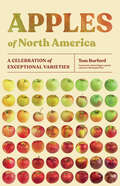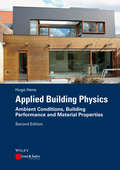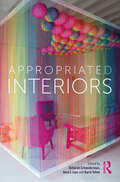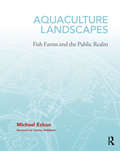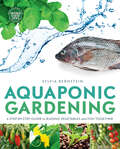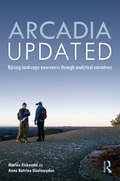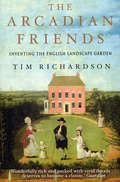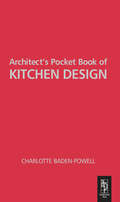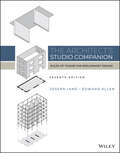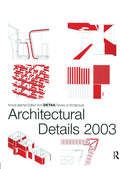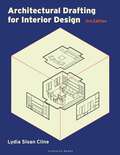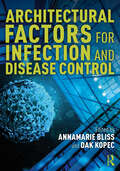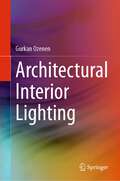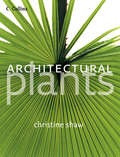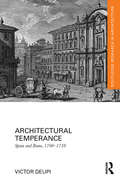- Table View
- List View
Apples of North America: A Celebration of Exceptional Varieties
by Tom BurfordThis celebration of apples will encourage readers to seek out new flavors, discover tasty methods of preservation, and maybe even try to grow their own at home.
Applied Building Physics: Ambient Conditions, Building Performance and Material Properties
by Hugo S. HensBad experiences with construction quality, the energy crises of 1973 and 1979,complaints about `sick buildings?, thermal, acoustical, visual and olfactory discomfort, the need for good air quality, the move towards more sustainability ? all these have accelerated the development of a field that, for a long time, was hardly more than an academic exercise: building physics. The discipline embraces domains such as heat and mass transfer, building acoustics, lighting, indoor environmental quality and energy efficiency. In some countries, fire safety is also included. Through the application of physical knowledge and its combination with information coming from other disciplines, the field helps to understand the physical phenomena governing building parts, building envelope, whole building and built environment performance, although for the last the wording `urban physics? is used. Building physics has a real impact on performance-based building design. This volume on `Applied Building Physics? discusses the heat, air and moisture performance metrics that affect building design, construction and retrofitting.
Applied Building Physics: Ambient Conditions, Building Performance and Material Properties
by Hugo S. HensBad experiences with construction quality, the energy crises of 1973 and 1979,complaints about `sick buildings?, thermal, acoustical, visual and olfactory discomfort, the need for good air quality, the move towards more sustainability ? all these have accelerated the development of a field that, for a long time, was hardly more than an academic exercise: building physics. The discipline embraces domains such as heat and mass transfer, building acoustics, lighting, indoor environmental quality and energy efficiency. In some countries, fire safety is also included. Through the application of physical knowledge and its combination with information coming from other disciplines, the field helps to understand the physical phenomena governing building parts, building envelope, whole building and built environment performance, although for the last the wording `urban physics? is used. Building physics has a real impact on performance-based building design. This volume on `Applied Building Physics? discusses the heat, air and moisture performance metrics that affect building design, construction and retrofitting.
Appropriated Interiors
by Deborah Schneiderman Anca I. Lasc Karin TehveAppropriated Interiors uncovers the ways interiors participate explicitly and implicitly in embedded cultural and societal values and explores timely emergent scholarship in the fields of interior design history, theory, and practice. What is "appropriate" and "inappropriate" now? These are terms with particular interest to the study of the interior. Featuring thirteen original curated essays, Appropriated Interiors explores the tensions between normative interiors that express the dominant cultural values of a society and interiors that express new, changing, and even transgressive values. With case studies from the late eighteenth century to the twenty-first century, these historians, theorists, and design practitioners investigate the implications of interior design as it relates to politics, gender, identity, spatial abstraction, cultural expression, racial expression, technology, and much more. An informative read for students and scholars of design history and theory, this collection considers the standards, assumptions, codes, and/or conventions that need to be dismantled and how we can expand our understanding of the history, theory, and practice of interior design to challenge the status quo.
Appropriated Interiors
by Deborah Schneiderman Anca I. Lasc Karin TehveAppropriated Interiors uncovers the ways interiors participate explicitly and implicitly in embedded cultural and societal values and explores timely emergent scholarship in the fields of interior design history, theory, and practice. What is "appropriate" and "inappropriate" now? These are terms with particular interest to the study of the interior. Featuring thirteen original curated essays, Appropriated Interiors explores the tensions between normative interiors that express the dominant cultural values of a society and interiors that express new, changing, and even transgressive values. With case studies from the late eighteenth century to the twenty-first century, these historians, theorists, and design practitioners investigate the implications of interior design as it relates to politics, gender, identity, spatial abstraction, cultural expression, racial expression, technology, and much more. An informative read for students and scholars of design history and theory, this collection considers the standards, assumptions, codes, and/or conventions that need to be dismantled and how we can expand our understanding of the history, theory, and practice of interior design to challenge the status quo.
AQA Design & Technology: Product Design (3-D Design) AS/A2 (PDF)
by Will Potts Brian EvansSpecifically written to cover AQA's Product Design (3-D Design) specification, our student book takes a focused look at design and manufacturing processes, providing a visual insight into specific products and industries to help motivate students. Clear learning objectives at the start of each chapter, helping students focus on what they need to know. Key terms reinforce learning, providing definitions of key words that students need to be familiar with. Includes a range of activities that encourages your students to analyse materials and manufacturing processes used in product design.
Aquaculture Landscapes: Fish Farms and the Public Realm
by Michael EzbanAquaculture Landscapes explores the landscape architecture of farms, reefs, parks, and cities that are designed to entwine the lives of fish and humans. In the twenty-first century, aquaculture’s contribution to the supply of fish for human consumption exceeds that of wild-caught fish for the first time in history. Aquaculture has emerged as the fastest growing food production sector in the world, but aquaculture has agency beyond simply converting fish to food. Aquaculture Landscapes recovers aquaculture as a practice with a deep history of constructing extraordinary landscapes. These landscapes are characterized and enriched by multispecies interdependency, performative ecologies, collaborative practices, and aesthetic experiences between humans and fish. Aquaculture Landscapes presents over thirty contemporary and historical landscapes, spanning six continents, with incisive diagrams and vivid photographs. Within this expansive scope is a focus on urban aquaculture projects by leading designers—including Turenscape, James Corner Field Operations, and SCAPE—that employ mutually beneficial strategies for fish and humans to address urban coastal resiliency, wastewater management, and other contemporary urban challenges. Michael Ezban delivers a compelling account of the coalitions of fish and humans that shape the form, function, and identity of cities, and he offers a forward-thinking theorization of landscape as the preeminent medium for the design of ichthyological urbanism in the Anthropocene. With over two hundred evocative images, including ninety original drawings by the author, Aquaculture Landscapes is a richly illustrated portrayal of aquaculture seen through the disciplinary lens of landscape architecture. As the first book devoted to this topic, Aquaculture Landscapes is an original and essential resource for landscape architects, urbanists, animal geographers, aquaculturists, and all who seek and value multispecies cohabitation of a shared public realm.
Aquaculture Landscapes: Fish Farms and the Public Realm
by Michael EzbanAquaculture Landscapes explores the landscape architecture of farms, reefs, parks, and cities that are designed to entwine the lives of fish and humans. In the twenty-first century, aquaculture’s contribution to the supply of fish for human consumption exceeds that of wild-caught fish for the first time in history. Aquaculture has emerged as the fastest growing food production sector in the world, but aquaculture has agency beyond simply converting fish to food. Aquaculture Landscapes recovers aquaculture as a practice with a deep history of constructing extraordinary landscapes. These landscapes are characterized and enriched by multispecies interdependency, performative ecologies, collaborative practices, and aesthetic experiences between humans and fish. Aquaculture Landscapes presents over thirty contemporary and historical landscapes, spanning six continents, with incisive diagrams and vivid photographs. Within this expansive scope is a focus on urban aquaculture projects by leading designers—including Turenscape, James Corner Field Operations, and SCAPE—that employ mutually beneficial strategies for fish and humans to address urban coastal resiliency, wastewater management, and other contemporary urban challenges. Michael Ezban delivers a compelling account of the coalitions of fish and humans that shape the form, function, and identity of cities, and he offers a forward-thinking theorization of landscape as the preeminent medium for the design of ichthyological urbanism in the Anthropocene. With over two hundred evocative images, including ninety original drawings by the author, Aquaculture Landscapes is a richly illustrated portrayal of aquaculture seen through the disciplinary lens of landscape architecture. As the first book devoted to this topic, Aquaculture Landscapes is an original and essential resource for landscape architects, urbanists, animal geographers, aquaculturists, and all who seek and value multispecies cohabitation of a shared public realm.
Aquaponic Gardening: A Step-by-step Guide to Raising Vegetables and Fish Together
by Sylvia Bernstein"The one source that will guide you from start to finish" (Gina Cavaliero, Aquaponi Inc) Aquaponi is a revolutionary way of gardening by combining the best of aquaculture and hydroponi. It is an amazingly fun and easy way to grow organic fruit and vegetables by simply fertilising them with waste water from fish. Aquaponic systems are completely organic, hugely productive and there's no weeding, watering, bending or digging. This is the definitive do-it-yourself manual giving you all the tools you need to create your own aquaponic system and enjoy fresh and healthy food all year round.
Arcadia Updated: Raising landscape awareness through analytical narratives
by Marius Fiskevold Anne Katrine GeelmuydenArcadia Updated delves into the concept of landscape as it is shaped by the literary tradition and material works known as pastoral. Referring to several of the tradition’s works as well as scholarly critiques, Fiskevold and Geelmuyden highlight how individual landscape perception is primarily a cultural construct: each individual may see a unique landscape based on personal experiences, but simultaneously, landscape represents a tradition of engaging with nature and land, which has been largely forgotten. In re-engaging and connecting the practice of understanding landscapes with the pastoral tradition, the authors establish a common ground for treating landscape as an object of analysis in landscape planning. Arcadia Updated contributes to the methodological debate concerning landscape character assessment. Including 30 black-and-white images, this book analyses how humans engage with land organically, materially and communicatively. It seeks to raise landscape awareness as both an individual and a collective act of imagination. The practice of analysing landscapes is an ongoing culture of reinterpreting the land as landscape in response to society’s development and technical progress. The role of the landscape analyst is to interpret the contemporary world and offer visual explanations of it. This book will be beneficial to professional landscape planners as well as to academics and students of landscape, literature and cultural studies. It provides an essential contribution to the cross-disciplinarity of the landscape discourse.
Arcadia Updated: Raising landscape awareness through analytical narratives
by Marius Fiskevold Anne Katrine GeelmuydenArcadia Updated delves into the concept of landscape as it is shaped by the literary tradition and material works known as pastoral. Referring to several of the tradition’s works as well as scholarly critiques, Fiskevold and Geelmuyden highlight how individual landscape perception is primarily a cultural construct: each individual may see a unique landscape based on personal experiences, but simultaneously, landscape represents a tradition of engaging with nature and land, which has been largely forgotten. In re-engaging and connecting the practice of understanding landscapes with the pastoral tradition, the authors establish a common ground for treating landscape as an object of analysis in landscape planning. Arcadia Updated contributes to the methodological debate concerning landscape character assessment. Including 30 black-and-white images, this book analyses how humans engage with land organically, materially and communicatively. It seeks to raise landscape awareness as both an individual and a collective act of imagination. The practice of analysing landscapes is an ongoing culture of reinterpreting the land as landscape in response to society’s development and technical progress. The role of the landscape analyst is to interpret the contemporary world and offer visual explanations of it. This book will be beneficial to professional landscape planners as well as to academics and students of landscape, literature and cultural studies. It provides an essential contribution to the cross-disciplinarity of the landscape discourse.
The Arcadian Friends
by Tim RichardsonBetween 1715 and 1750, a group of politicans and poets, farmers and businessmen, heiresses and landowners began to experiment with the phenomenon that was to become the English landscape garden. Arguably the greatest British art form ever invented, these gardens were built to charm and delight, to shock and inspire all who visited. That these gardens - including Castle Howard, Stowe, Painshill and Rousham - are still so popular with visitors today is a testament to the innovation and passion of this extraordinary group of eccentrics and visionaries.The Arcadian Friends takes a highly engaging perspective on the politics and culture of England during the Enlightenment. At the same time it will be required reading for the legions of fans of the great gardens of England.Tim Richardson introduces us to a period of poltical and personal intrigue, where fantastic biblical landscapes competed for space with temples to sexual freedom; and where the installation of a water feature was a political act. The Arcadian Friends tells the story of a collection of fascinating characters whose influence changed the landscape of Britain for ever.
Architect's Pocket Book of Kitchen Design (Routledge Pocket Books)
by Charlotte Baden-PowellAs with the best-selling 'Architects Pocket Book' this title includes everyday information which the architect/designer normally has to find from a wide variety of sources and which is not always easily to hand.Focusing on kitchen design, this book is of use to the student as well as the experienced practitioner. It outlines all the information needed to design a workable kitchen, including ergonomics, services such as water and waste, appliances, and material choices for the floor, walls and ceiling. There is no similar compendium currently available.
Architect's Pocket Book of Kitchen Design (Routledge Pocket Books)
by Charlotte Baden-PowellAs with the best-selling 'Architects Pocket Book' this title includes everyday information which the architect/designer normally has to find from a wide variety of sources and which is not always easily to hand.Focusing on kitchen design, this book is of use to the student as well as the experienced practitioner. It outlines all the information needed to design a workable kitchen, including ergonomics, services such as water and waste, appliances, and material choices for the floor, walls and ceiling. There is no similar compendium currently available.
The Architect's Studio Companion: Rules of Thumb for Preliminary Design
by Joseph Iano Edward AllenTHE ARCHITECT’S STUDIO COMPANION The latest edition of the guidebook every architect needs at their fingertips, updated and expanded throughout Start your designs on solid ground with The Architect’s Studio Companion! This comprehensive handbook provides everything you need for the preliminary selecting, configuring, and sizing of the structural, environmental, safety, accessibility, and parking systems of a building. Edward Allen and Joseph Iano, authors of the market-leading Fundamentals of Building Construction, use their trademark talent for boiling down complex technical requirements into easy-to-use, time-saving guidelines for the engineering and architectural design of buildings. The new seventh edition is updated with new building codes, new information on heating and cooling systems for buildings, new structural systems, new requirements for tall mass timber buildings, and more. Throughout the text, straightforward diagrams and user-friendly explanations help you lay out the most important systems of a building in a matter of minutes without stressing about complicated technical concepts. Use this guide to introduce building systems into the early stages of design, and greatly reduce the need for later revisions or redesign???and keep your projects on time and on budget. Streamline your design process today with The Architect’s Studio Companion: Explore alternative structural systems quickly and efficiently Compare the carbon impacts of alternative system choices… at a glance Stay current with the latest information about tall mass timber buildings Access information on high-performance heating and cooling systems, passive design, natural daylighting, and other sustainable design strategies with ease Incorporate U.S. and Canadian building code requirements and accessibility regulations into your designs More than just a reference, The Architect’s Studio Companion, Seventh Edition is a must-have companion that no practicing architect or student should be without.
The Architect's Studio Companion: Rules of Thumb for Preliminary Design
by Joseph Iano Edward AllenTHE ARCHITECT’S STUDIO COMPANION The latest edition of the guidebook every architect needs at their fingertips, updated and expanded throughout Start your designs on solid ground with The Architect’s Studio Companion! This comprehensive handbook provides everything you need for the preliminary selecting, configuring, and sizing of the structural, environmental, safety, accessibility, and parking systems of a building. Edward Allen and Joseph Iano, authors of the market-leading Fundamentals of Building Construction, use their trademark talent for boiling down complex technical requirements into easy-to-use, time-saving guidelines for the engineering and architectural design of buildings. The new seventh edition is updated with new building codes, new information on heating and cooling systems for buildings, new structural systems, new requirements for tall mass timber buildings, and more. Throughout the text, straightforward diagrams and user-friendly explanations help you lay out the most important systems of a building in a matter of minutes without stressing about complicated technical concepts. Use this guide to introduce building systems into the early stages of design, and greatly reduce the need for later revisions or redesign???and keep your projects on time and on budget. Streamline your design process today with The Architect’s Studio Companion: Explore alternative structural systems quickly and efficiently Compare the carbon impacts of alternative system choices… at a glance Stay current with the latest information about tall mass timber buildings Access information on high-performance heating and cooling systems, passive design, natural daylighting, and other sustainable design strategies with ease Incorporate U.S. and Canadian building code requirements and accessibility regulations into your designs More than just a reference, The Architect’s Studio Companion, Seventh Edition is a must-have companion that no practicing architect or student should be without.
Architectural Details 2003
by Detail MagazineThis is a compilation of the full year's information, including: the "Discussion" section, where well-known architects and critics as well as specialist authors and architectural historians articulate their views; the "Documentation" section containing an analysis of selected projects, in which buildings from around the world are covered in depth; and the "Technology" section where the specific theme of each issue of the magazine is treated in greater depth. Along with these are illustrations of the high standards that Detail is known for, where all plan drawings are true to scale and have been approved by the architects, planners and engineers responsible for the original design.This annual sourcebook is a beautiful record, not only of the year's Detail publication, but of some of the best, and most innovative contemporary architecture
Architectural Details 2003
by Detail MagazineThis is a compilation of the full year's information, including: the "Discussion" section, where well-known architects and critics as well as specialist authors and architectural historians articulate their views; the "Documentation" section containing an analysis of selected projects, in which buildings from around the world are covered in depth; and the "Technology" section where the specific theme of each issue of the magazine is treated in greater depth. Along with these are illustrations of the high standards that Detail is known for, where all plan drawings are true to scale and have been approved by the architects, planners and engineers responsible for the original design.This annual sourcebook is a beautiful record, not only of the year's Detail publication, but of some of the best, and most innovative contemporary architecture
Architectural Drafting for Interior Design: - with STUDIO
by Lydia Sloan ClineWhile traditional drafting books focus on architectural and engineering readers, the thoroughly updated and revised Architectural Drafting for Interior Design, Third Edition, incorporates material and examples that are meaningful to today's interior designers. Beginning interior designers will learn how to communicate their ideas graphically with a resource that is designed specifically for them. This book addresses their needs by focusing on topics independent of CAD, such as how to draw a floor plan, how to use it to create an interior elevation, and how to understand the relationship between 2D and 3D drawings. Written with NCIDQ, CIDA and NKBA requirements in mind, this book will provide readers with a strong, standards-based foundation in interior design. New to this Edition:- Enhanced and new worksheets- New design and drafting information, including updated visuals and symbols- Emerging technologies such as photogrammetry and 3D printing STUDIO Features:- Study smarter with self-quizzes featuring scored results and personalized study tips- Review concepts with flashcards of essential vocabulary- Download floor plan templates and worksheets to practice your drafting skills Instructor Resources:- The Instructor's Guide provides suggestions for planning the course and using the text in the classroom, supplemental assignments, grading rubrics, and a CIDA Professional Standards Matrix mapped to the chapters in the book- The Test Bank includes sample test questions for each chapter- PowerPoint® presentations include images from the book and provide a framework for lecture and discussion
Architectural Factors for Infection and Disease Control
by AnnaMarie Bliss Dak KopecThis edited collection explores disease transmission and the ways that the designed environment has promoted or limited its spread. It discusses the many design factors that can be used for infection and disease control through lenses of history, public health, building technology, design, and education.This book calls on designers to consider the role of the built environment as the primary source of bacterial, viral, and fungal transfers through fomites, ventilation systems, and overcrowding and spatial organization. Through 19 original contributions, it provides an array of perspectives to understand how the designed environment may offer a reprieve from disease. The authors build a historical foundation of infection and disease, using examples ranging from lazarettos to leprosy centers to show how the ability to control infection and disease has long been a concern for humanity. The book goes on to discuss disease propagation, putting forth a variety of ideas to control the transmission of pathogens, including environmental design strategies, pedestrian dynamics, and open space. Its final chapters serve as a prospective way forward, focusing on COVID-19 and the built environment in a post-pandemic world.Written for students and academics of architecture, design, and urban planning, this book ignites creative action on the ways to design our built environment differently and more holistically.Please note that research on COVID-19 has exponentially grown since this volume was written in October 2020. References cited reflect the evolving nature of research studies at that time.
Architectural Factors for Infection and Disease Control
by AnnaMarie Bliss Dak KopecThis edited collection explores disease transmission and the ways that the designed environment has promoted or limited its spread. It discusses the many design factors that can be used for infection and disease control through lenses of history, public health, building technology, design, and education.This book calls on designers to consider the role of the built environment as the primary source of bacterial, viral, and fungal transfers through fomites, ventilation systems, and overcrowding and spatial organization. Through 19 original contributions, it provides an array of perspectives to understand how the designed environment may offer a reprieve from disease. The authors build a historical foundation of infection and disease, using examples ranging from lazarettos to leprosy centers to show how the ability to control infection and disease has long been a concern for humanity. The book goes on to discuss disease propagation, putting forth a variety of ideas to control the transmission of pathogens, including environmental design strategies, pedestrian dynamics, and open space. Its final chapters serve as a prospective way forward, focusing on COVID-19 and the built environment in a post-pandemic world.Written for students and academics of architecture, design, and urban planning, this book ignites creative action on the ways to design our built environment differently and more holistically.Please note that research on COVID-19 has exponentially grown since this volume was written in October 2020. References cited reflect the evolving nature of research studies at that time.
Architectural Interior Lighting
by Gurkan OzenenArchitectural Interior Lighting is an essential guide to creating well-lit, visually appealing interior spaces. The book begins with an overview of light and color theory, lighting fundamentals, and design principles. It then covers artificial, natural, decorative, and professional lighting in interior design, as well as standards and regulations, controls and systems, sustainable lighting, energy efficiency, light pollution reduction, and the use of environmentally friendly materials. With a focus on practical applications and real-world examples, this book provides readers with the tools and knowledge necessary to achieve their design goals while considering the latest trends and techniques in the field. A valuable resource for professionals and students in architecture and lighting design, it will also appeal to anyone interested in creating visually stunning and functional interior spaces.
Architectural Plants: What To Grow And How To Grow It (Practical Gardener Ser.)
by Christine ShawA definitive guide to the spectacular world of architectural plants, packed with practical advice on how to liven up your garden using the striking shapes and wonderful exoticism of this distinct new area of planting. Whether amateur or expert, this ebook is essential reading for any gardener looking for something a bit special to grow.
Architectural Temperance: Spain and Rome, 1700-1759 (Routledge Research in Architecture)
by Victor DeupiArchitectural Temperance examines relations between Bourbon Spain and papal Rome (1700-1759) through the lens of cultural politics. With a focus on key Spanish architects sent to study in Rome by the Bourbon Kings, the book also discusses the establishment of a program of architectural education at the newly founded Real Academia de Bellas Artes de San Fernando in Madrid. Victor Deupi explores why a powerful nation like Spain would temper its own building traditions with the more cosmopolitan trends associated with Rome; often at the expense of its own national and regional traditions. Through the inclusion of previously unpublished documents and images that shed light on the theoretical debates which shaped eighteenth-century architecture in Rome and Madrid, Architectural Temperance provides readers with new insights into the cultural history of early modern Spain.
Architectural Temperance: Spain and Rome, 1700-1759 (Routledge Research in Architecture)
by Victor DeupiArchitectural Temperance examines relations between Bourbon Spain and papal Rome (1700-1759) through the lens of cultural politics. With a focus on key Spanish architects sent to study in Rome by the Bourbon Kings, the book also discusses the establishment of a program of architectural education at the newly founded Real Academia de Bellas Artes de San Fernando in Madrid. Victor Deupi explores why a powerful nation like Spain would temper its own building traditions with the more cosmopolitan trends associated with Rome; often at the expense of its own national and regional traditions. Through the inclusion of previously unpublished documents and images that shed light on the theoretical debates which shaped eighteenth-century architecture in Rome and Madrid, Architectural Temperance provides readers with new insights into the cultural history of early modern Spain.
